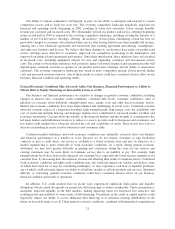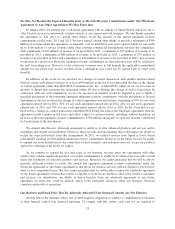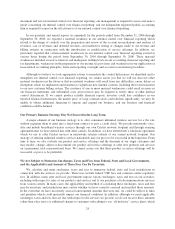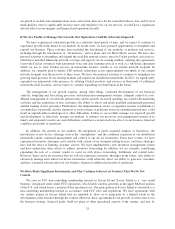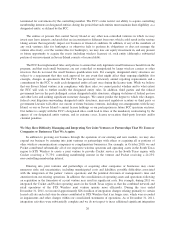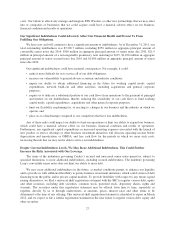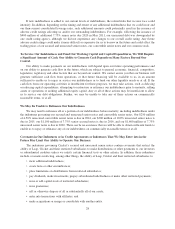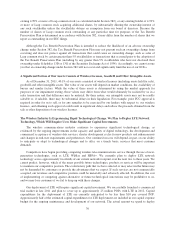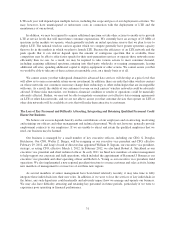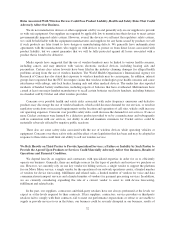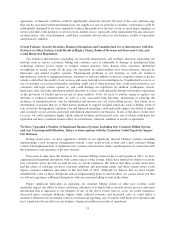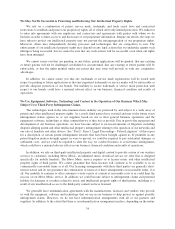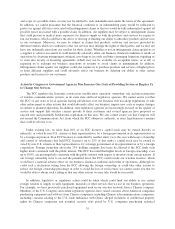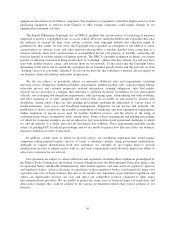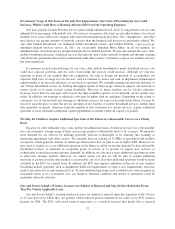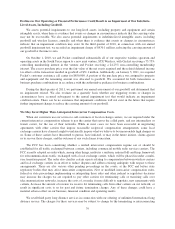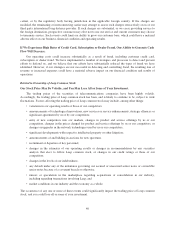Cricket Wireless 2011 Annual Report Download - page 40
Download and view the complete annual report
Please find page 40 of the 2011 Cricket Wireless annual report below. You can navigate through the pages in the report by either clicking on the pages listed below, or by using the keyword search tool below to find specific information within the annual report.owning 4.99% or more of Leap common stock (as calculated under Section 382), or any existing holder of 4.99%
or more of Leap common stock acquiring additional shares, by substantially diluting the ownership interest of
any such stockholder unless the stockholder obtains an exemption from our board of directors. Because the
number of shares of Leap common stock outstanding at any particular time for purposes of the Tax Benefit
Preservation Plan is determined in accordance with Section 382, it may differ from the number of shares that we
report as outstanding in our SEC filings.
Although the Tax Benefit Preservation Plan is intended to reduce the likelihood of an adverse ownership
change under Section 382, the Tax Benefit Preservation Plan may not prevent such an ownership change from
occurring and does not protect against all transactions that could cause an ownership change, such as sales of
Leap common stock by certain greater than 5% stockholders or transactions that occurred prior to the adoption of
the Tax Benefit Preservation Plan (including by any greater than 5% stockholders who have not disclosed their
ownership under Schedules 13D or 13G of the Securities Exchange Act of 1934). Accordingly, we cannot assure
you that an ownership change under Section 382 will not occur and significantly limit the use of our NOLs.
A Significant Portion of Our Assets Consists of Wireless Licenses, Goodwill and Other Intangible Assets.
As of December 31, 2011, 40.1% of our assets consisted of wireless licenses (including assets held for sale),
goodwill and other intangible assets. The value of our assets will depend on market conditions, the availability of
buyers and similar factors. While the value of these assets is determined by using the market approach for
purposes of our impairment testing, those values may differ from what would ultimately be realized by us in a
sales transaction and that difference may be material. By their nature, our intangible assets may not be readily
saleable or, if saleable, there may be substantial delays in their liquidation. For example, prior FCC approval is
required in order for us to sell, or for any remedies to be exercised by our lenders with respect to, our wireless
licenses, and obtaining such approval could result in significant delays and reduce the proceeds obtained from the
sale or other disposition of our wireless licenses.
The Wireless Industry Is Experiencing Rapid Technological Change. We Plan to Deploy LTE Network
Technology, Which Will Require Us to Make Significant Capital Investments.
The wireless communications industry continues to experience significant technological change, as
evidenced by the ongoing improvements in the capacity and quality of digital technology, the development and
commercial acceptance of wireless data services, shorter development cycles for new products and enhancements
and changes in end-user requirements and preferences. Our continued success will depend, in part, on our ability
to anticipate or adapt to technological changes and to offer, on a timely basis, services that meet customer
demands.
Competitors have begun providing competing wireless telecommunications service through the use of next-
generation technologies, such as LTE, WiMax and HSPA+. We currently plan to deploy LTE network
technology across approximately two-thirds of our current network footprint over the next two to three years. We
cannot predict, however, which of the many possible future technologies, products or services will be important
to maintain our competitive position. The evolutionary path that we have selected or may select in the future may
not be demanded by customers or provide the advantages that we expect. If such services are not commercially
accepted, our revenues and competitive position could be materially and adversely affected. In addition, the cost
of implementing or competing against alternative or future technological innovations may be prohibitive to us,
and we may lose customers if we fail to keep up with these changes.
Our deployment of LTE will require significant capital investment. We successfully launched a commercial
trial market in late 2011 and plan to cover up to approximately 25 million POPs with LTE in 2012. Capital
expenditures for the deployment of LTE are currently anticipated to be less than $10 per covered POP.
Approximately half of the estimated capital expenditures for LTE deployment are included in our capital expense
budget for the ongoing maintenance and development of our network. The actual amount we spend to deploy
30



